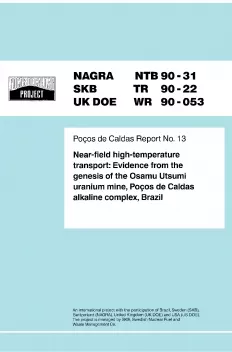
Technical Report NTB 90-31
Poços de Caldas Report No. 13Near-field high-temperature transport: Evidence from the genesis of the Osamu Utsumi uranium mine, Poços de Caldas alkaline complex, Brazil
The chemical, isotopic and mineralogical alteration which occurred during primary uranium ore deposition at the breccia pipe-hosted Osamu Utsumi mine, Poços de Caldas, Brazil, was studied as a natural analogue for near-field radionuclide migration. Chemical and isotopic alteration models were combined with finite difference models of the convective cooling of caldera intrusives. The modelling indicates that the intense chemical, isotopic and mineralogical alteration of the Osamu Utsumi breccia pipe requires the circulation of > 105 kg of boiling hydrothermal fluid > 220°C through each square centimetre cross-section of the pipe. The circulation can be driven by heat from a 6 km diameter intrusion extending to 10 km depth. Even with this large amount of circulation concentrated in the permeable breccia pipe, uranium solubilities must be 2 1/2 orders of magnitude greater than indicated in the most recent experiments (and more in line with previous estimates) to produce the primary uranium mineralization at the Osamu Utsumi mine.
The same models applied to a hypothetical high-temperature waste repository show that heat from radioactive decay will produce a hydrothermal circulation system remarkably similar to that studied at the natural analogue site at Poços de Caldas. The depth of fluid convection induced by the hypothetical repository would be 5 to 10 km, the maximum temperature ~ 300°C, the lifetime of the high-temperature phase a few 1000s of years and boiling would cause most of the alteration of the waste repository. The physical analysis emphasizes the importance of permeability on a 10 × 10 × 10 km scale in controlling the potential amount of circulation through the hypothetical repository.
Application of the chemical models successfully used to interpret mineralization and alteration at the Osamu Utsumi mine to the hypothetical waste repository shows that, even in a worst case scenario (waste emplaced in a permeable host rock with no measures taken to inhibit flow through the repository), the amount of hydrothermal alteration in the hypothetical repository will be ~ 0.1 % of that in the breccia pipe at the Osamu Utsumi mine. Assuming no barriers to uranium mobility, uranium precipitation above the hypothetical repository would be 0.05 ppm (rather than 50 ppm), hydrothermal alteration 0.03 wt.% (rather than 30 wt.%), etc.
The analysis indicates that mineralogical alteration is extremely sensitive to thermodynamic data. Prediction of mineralogical alteration (which may be necessary to predict the migration of radionuclides other than uranium, for example) probably cannot be based directly on even very carefully collected laboratory thermodynamic data. Mineralogical complexities of the system, as well as database uncertainties, will require calibration of the thermodynamic framework against mineralogical alteration observed in the laboratory or field by procedures briefly described.
